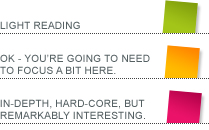Unfortunately, there is a reason not to use HTML5 tags – Internet Explorer 7.
In the early days of browsers, Internet Explorer used a completely different way of laying out elements on a page (called the box-model) from the other, more standards-compliant browsers. With the release of IE6 and then IE7, Microsoft compromised by allowing developers to choose which box model to use. The default was still the Microsoft version, but developers could signify that the browser should use the standards-compliant mode using a tag at the top of the code called a doctype.
Later versions of IE
Once IE8 and now IE9 were released, the default mode was standards compliant, and the old Microsoft model is falling away. But, for IE7 compatibility, we must still include the correct doctype, and IE7 is definitely still in use.
This causes a problem with HTML5, because HTML5 requires its own doctype to identify itself to browsers. IE7 doesn’t recognise this doctype at all, and ignores it, reverting to displaying using the old Microsoft box model.
Just to be clear, developing sites for the two models is a nightmare, and I had sincerely hoped I would never have to face that again. It required essentially developing the entire layout for each site twice. That is irritating enough in a static site, but when the code is dynamically generated, it can become extremely convoluted.
Why support IE7?
So why don’t we just stop supporting IE7? It is now two generations behind the current IE version, so surely it should be disappearing into history by now?
Well, we have two criteria on which we base our decisions to support a browser version or not:
- Does it have a significant share of browser usage?
- Do our clients use it themselves?
Unfortunately, some of our clients do still use IE7, so we do need to support it, even if our clients were the only people in the world who used it. It is almost impossible to explain to a client that their site looks good on everyone else’s browser, even though it looks horrible on theirs. I wouldn’t believe me if I was them.
How many users?
But our clients aren’t the only people who still use IE7. In fact, about 10% of all users still use IE7. That’s not much less than all Firefox users, and is about the same as all Google Chrome and Safari users. This figure is slowly going down, and will (hopefully) soon become far less significant, but for now, unfortunately, we must still support IE7.
Which means no HTML5. For the time being. But we’re keeping an eye on things, and as soon as we can we’ll start using the new HTML5 tags.


